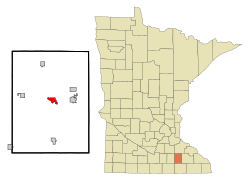Dodge Center, Minnesota
| Dodge Center, Minnesota | |
|---|---|
| City | |

Downtown Dodge Center
|
|
| Nickname(s): Dodge, DC | |
| Motto: "A Solid Foundation" | |
 Location of Dodge Center within Dodge County and state of Minnesota |
|
| Coordinates: 44°1′44″N 92°51′18″W / 44.02889°N 92.85500°WCoordinates: 44°1′44″N 92°51′18″W / 44.02889°N 92.85500°W | |
| Country | United States |
| State | Minnesota |
| County | Dodge |
| Area | |
| • Total | 2.08 sq mi (5.39 km2) |
| • Land | 2.08 sq mi (5.39 km2) |
| • Water | 0 sq mi (0 km2) |
| Elevation | 1,293 ft (394 m) |
| Population (2010) | |
| • Total | 2,670 |
| • Estimate (2012) | 2,676 |
| • Density | 1,283.7/sq mi (495.6/km2) |
| Time zone | Central (CST) (UTC-6) |
| • Summer (DST) | CDT (UTC-5) |
| ZIP code | 55927 |
| Area code(s) | 507 |
| FIPS code | 27-15994 |
| GNIS feature ID | 0642860 |
| Website | www.ci.dodgecenter.mn.us |
Dodge Center, is a city in Dodge County, Minnesota, United States. Approximately 15 miles west of Rochester, the population of Dodge Center was 2,670 at the 2010 census. Dodge Center is part of the Rochester, MN Metropolitan Statistical Area.
The Dodge Center area was first settled by pioneers in the 1850s. The town was created by the railroad system and named for its central location within Dodge County, Minnesota, which was named for Henry Dodge, twice the governor of Wisconsin.
The first train to reach Dodge Center arrived on July 13, 1866. Shortly after, D.L. Tyler moved to Dodge Center from Ashland (which had no railroad) and built its first general store in 1867. Tyler also became the town's first postmaster.
Dodge Center's site was officially platted in 1867 and recorded in July 1869. In January 1870, the legislature passed a bill changing the town's name to Silas. The bill was reconsidered the next day and no further action was taken. The town remained Dodge Center and was incorporated in February 1872 by special act of the legislature.
Early Dodge Center was a farming community known for growing grain. Grain wagons lined up and down Main Street and into the surrounding countryside waiting their turn at either of two grain elevators.
By 1870, Dodge Center's population had grown to 400-500. The two grain elevators, a gun shop, Tyler's general store and The Kinney House (a hotel widely known in the region and later burned) had become established businesses. The Chicago and North Western Railroad depot had also been completed. Also by 1870, the one-room schoolhouse, in which a Mrs. Rice taught, had become too small. Realizing the importance of education, the people of Dodge Center built a wooden, L-shaped, two-story schoolhouse, costing about $15,000. The first high school commencement exercises were held in 1885.[2] When that school was also outgrown, a new brick building was constructed in 1898.
The 1870 school was cut in half and converted. One half became an opera house (where the Assembly of God church now stands) and the other half became apartments directly across the street. The opera house was one of the grandest in southeastern Minnesota, with a large stage, balcony and opera seats. The opera house eventually became a church and was destroyed by fire in 1948. The apartments were demolished in the 1980s.
...
Wikipedia
